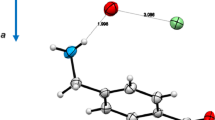Abstract
The reaction of triphenylbismuth dichloride with sodium fluoride in acetone leads to formation of triphenylbismuth difluoride in 73% yield. The X-ray diffraction data show that the bismuth atom in the two symmetrically independent molecules of bismuth difluoride has a trigonal-bipyramidal coordination with equatorial fluorine atoms. The Bi-F and Bi-C distances are 2.53(1)-2.59(1) and 2.10(3)-2.22(2) Å, respectively, and the FBiF angle is 175.1(5)°.
Similar content being viewed by others
REFERENCES
Challenger, F. and Wilkinson, J.F., J. Chem. Soc., 1922, vol. 121, pp. 91-94
Goel, R.C. and Prasad, H.S., Can. J. Chem., 1970, vol. 48, pp. 2488-2493
Ferguson, G., Kaither, B., Glidevell, C., and Smith, S., J. Organomet. Chem., 1991, vol. 419, no. 2, pp. 283-291
Sheldrick, G.M., SHELXL-97, Goettingen: Univ. of Goettingen, 1997.
Author information
Authors and Affiliations
Rights and permissions
About this article
Cite this article
Sharutin, V.V., Sharutina, O.K., Egorova, I.V. et al. Synthesis and Structure of Triphenylbismuth Difluoride. Russian Journal of General Chemistry 72, 44–45 (2002). https://doi.org/10.1023/A:1015328925333
Issue Date:
DOI: https://doi.org/10.1023/A:1015328925333




